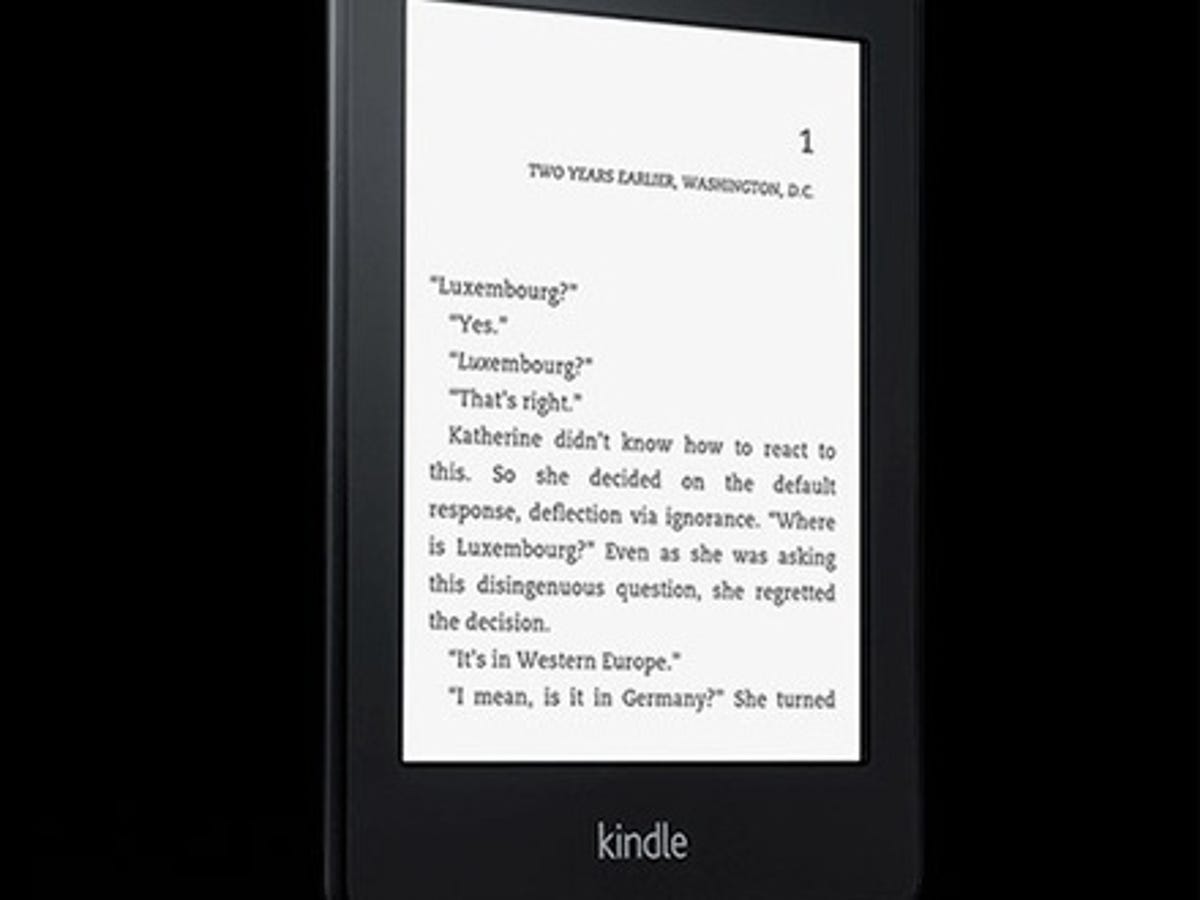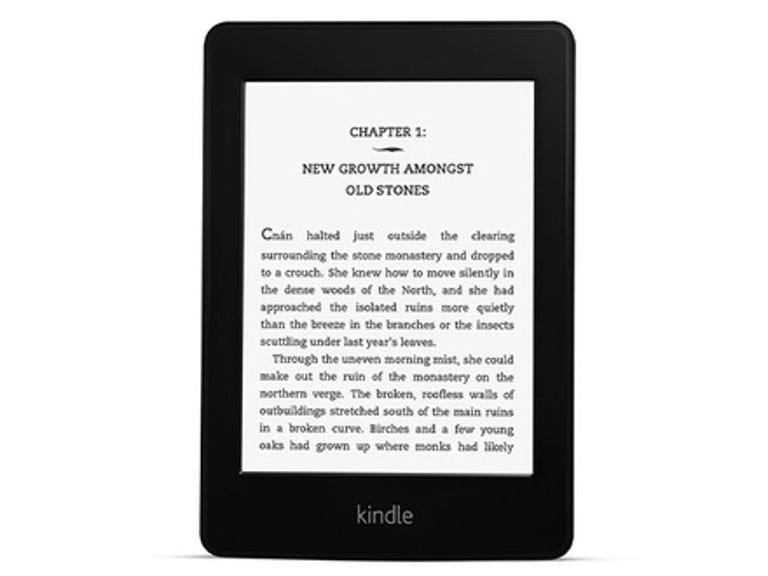 Why You Can Trust CNET
Why You Can Trust CNET Amazon Kindle Paperwhite review: Amazon Kindle Paperwhite 2012
The Amazon Kindle Paperwhite is a great ebook reader, with a built-in light that makes for clear, comfortable reading, even in the dark.
Amazon hasn't put a foot wrong yet when it comes to ebook readers -- since the keyboard-touting Kindle 3G made its UK debut in October 2010, we've enjoyed a strong line-up of E Ink gadgets that deliver literary thrills at a reasonable cost.
The Good
The Bad
The Bottom Line
The Kindle Paperwhite is the latest Kindle device vying for your cash, featuring a glowing backlight as well as a touchscreen. Starting at £109 for the Wi-Fi-only version and £60 more if you want 3G connectivity, it's by no means the cheapest e-reader out there, so is it worth the extra dosh?
Should I buy the Kindle Paperwhite?
If you already own a Kindle or another E Ink device, while the new features offered by the Paperwhite are definitely great additions, you shouldn't feel at pains to upgrade.
If you don't mind spending the cash and are currently using the 2010 keyboard Kindle then you'll definitely feel the benefit of the decreased size the Paperwhite offers, but don't expect a revolutionary experience. The Paperwhite is the best Kindle yet, but it's hardly a life-changing upgrade.
If you often read at night, or work down a mine and like skiving off for a quick chapter, then the glowing light on this e-book reader will make your life much easier. My advice would be to take stock of how often you read in dim or low light -- do you usually get your literature kicks in the living room on a lazy Sunday? Or in bed, once your significant other has nodded off?

If you decide to buy, you'll also have to consider whether you want the 3G version or not. If you travel frequently, the free 3G will come in handy very quickly and will justify the extra cost. If you rarely read outside your house, you'll be fine with the Wi-Fi option. For more on Amazon's 3G service, see the relevant section below.
Design
The Paperwhite ditches the grey coating we've seen on earlier Kindle gadgets in favour of a sultry black hue. At 11.7cm across and 16.9cm tall, it's small enough to easily squeeze inside a rucksack or handbag and -- at a push -- you'll even get the Paperwhite inside a spacious pocket.
It's slim at 9.1mm, which is about as thick as a modern smart phone and thinner than the earlier Kindle Touch by a centimetre. It weighs the same at 213g, which is light enough that you won't feel the bulk if you're carrying it around all day, although you'll notice the 43g boost over the regular Kindle. The 3G model is a slightly heftier 222g.
There's no home button any more, which may briefly flummox you if you're used to the older, button-filled Kindle devices, all of which have at least one physical button on their front. That button used to jump you back to the Kindle's home screen, where you could select the book you were reading.
I found I didn't miss this button, however. Once you start reading a book, the odds are you won't need to jump back to the home screen until you've finished, which could be weeks later. If you do need to get to the Paperwhite's main menu, you can do so by tapping near the top of the screen, then pressing the icon that looks like a house.
Light-up screen
This is the first Kindle to feature a light, making it possible to read in the dark. Rather than beaming a light out from behind the display, tiny lights have been stuck into the side of the Paperwhite's screen and illuminate the whole page.
This new feature works very well indeed. The light is subtle, with a blue tint that isn't distractingly bright, and the glow it casts is very even, so you won't be distracted by any particularly luminous patches on the page.
If you look at the Kindle on its side, you can just about see where the light is coming from, but I didn't find it distracting. You can adjust the brightness by tapping near the top of the screen and pressing on the lightbulb icon, which presents a slider you can drag to dial the glow up or turn it off completely.
All things considered, the light is an excellent new feature. Any ebook enthusiast will know the frustration of squinting at an unlit display in fading light -- a pain that the Paperwhite's glowing display instantly removes.
Amazon says it has beefed up the pixel count and the contrast with the Paperwhite, which in theory means text will appear crisper on the page. I found, however, that a side-by-side comparison with the Kindle Touch showed barely any discernible difference between the two displays.
That's not to criticise -- text still looks very sharp and is easy to read, but don't expect a revolutionary reading experience, as this Kindle's on-screen text looks very similar to that of its predecessor.
Amazon isn't the only company flogging a glowing ebook reader -- there's also the £109 Barnes and Noble Nook Simple Touch with GlowLight, or the £100 Kobo Glo, available from WH Smiths. In a comparison I'd say Amazon's light offers more even lighting than Barnes and Noble's option, but the Kobo has a great switch-activated light and is well worth bearing in mind, especially if you're trying to save your pennies.
Touchscreen display and control
The Paperwhite is controlled entirely by touchscreen and sees you turning virtual pages by tapping either on the left or the right of the display. For the most part, this works just as well as the physical buttons that straddle the less fancy £69 Kindle, but there are some drawbacks.
For example, the area of the page you tap to turn back one page is quite slim, and I've occasionally found myself skipping forwards a page when I meant to move backwards. If you use your Kindle on public transport and often change buses or trains, also be aware that you may accidentally skip ahead loads of pages as you walk with it gripped in your hand.
A few quibbles then, but the touchscreen itself is hard to fault. It's sensitive enough that it hardly ever fails to register a prod, and makes typing search terms and book titles a speedy affair -- something that's often frustrating on the cheaper button-controlled Kindle.
3G or not 3G?
That is the question. Unlike devices like the iPad, which have a 3G option that requires you to buy a SIM-card and pay a network a monthly fee to use its services, the Kindle's mobile data is free.
You can use this free wireless data to download books on the go, even if you're abroad. Almost all of Europe is covered, as is the United States. If you power through a book faster than planned while on holiday, the ability to simply grab another one at no extra cost is a life saver.
The Kindle also has an 'experimental browser', which lets you do some primitive web browsing and searching. The E Ink screen means web pages aren't too attractive to look at, but if you have the 3G version, you can use the free mobile data to quickly check your emails on holiday, or if your smart phone's battery has died.
The 3G option comes in handy when you're abroad or when stranded without another Internet-capable device. It's an excellent addition, so if you're not shopping on a tight budget, I'd recommend buying the £169 3G Paperwhite.
It is a whole £60 more expensive than the cheaper Wi-Fi-only model though, and if you go for the Wi-Fi option, you'll only be missing out on a few luxury features. If your wallet could use a rest in the run-up to Christmas, don't be afraid to ditch 3G.
Interface and buying books
As you'd expect, you buy Kindle books through Amazon's own online shop, which has a vast selection and a great many reasonably priced novels, especially when it comes to classics, lots of which are now dirt-cheap to download.
Navigating the online shop is easy enough and you can also opt for samples of books if you'd like to try before you buy. There is a downside though -- Amazon restricts you to only reading books that you download via its own shop. You can squeeze .pdf or Word files onto the Kindle by email, but the popular .epub file format used by many websites and public libraries is not supported.
There's also no external storage, so you can't download an ebook from any old website, put it on a memory stick and start reading it on your Kindle. Rival devices like the Kobo or Sony's ebook readers can handle these file formats, so that's something to bear in mind if you frequent ebook download sites other than Amazon's own.
Amazon says you can expect eight weeks of charge, based on half an hour per day of reading with the wireless switched off and the light set to roughly a third of its brightness. In practice, you'll probably read for longer stretches than that but I've not experienced any problems with the Paperwhite's battery so far.
Thanks to E Ink's low power requirements, the Kindle could easily last you a whole holiday without needing to suck on its power cable. I've found it will often last for days beyond its 'low power' warning. If you're trying to extend battery life, just turn off Wi-Fi and 3G and turn the brightness down.
Conclusion
The Paperwhite is a welcome addition to the Kindle family, even if its glowing light is really the only new feature worth buying it for. If you're using an older Kindle or if you're new to the world of ebooks, this is a good choice, although the £69 Kindle is still appealing if you're trying to save cash.
If you're happy to buy books exclusively from Amazon, you'll be attracted to the simplicity of the Kindle's shopping process. Anyone looking to buy .epub files from ebook websites or public libraries, however, would be wise to investigate the Kobo Glo.


